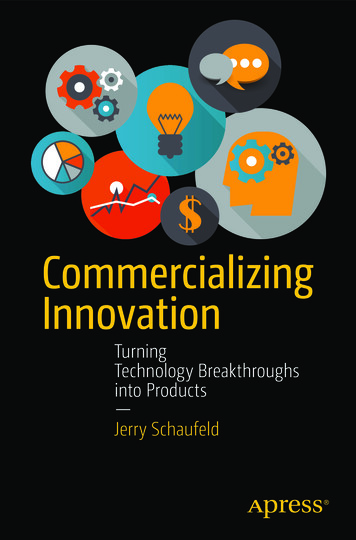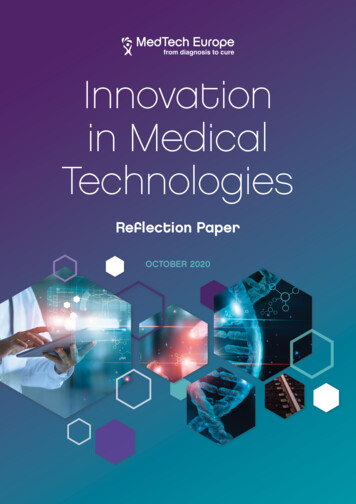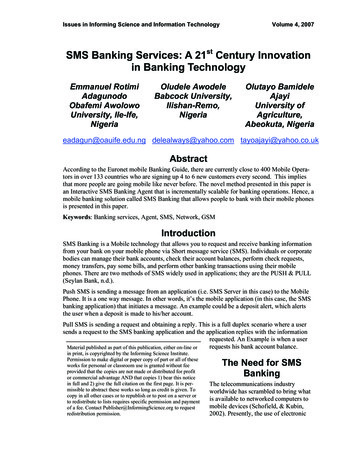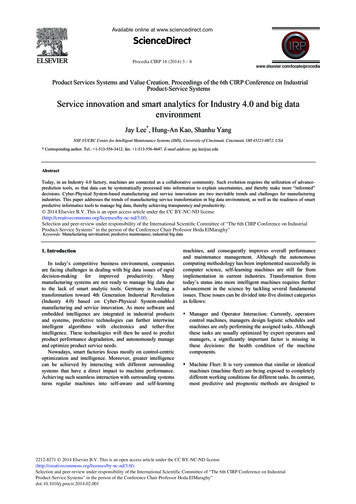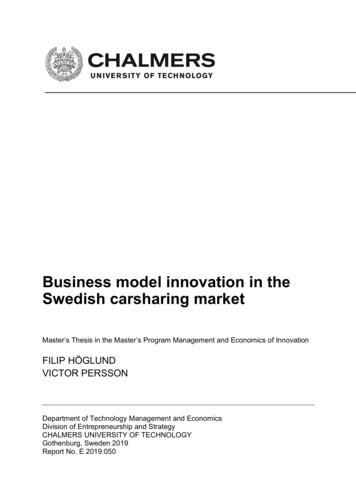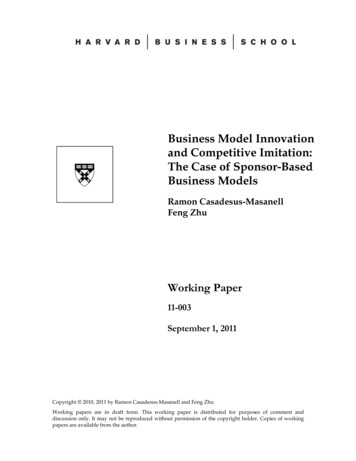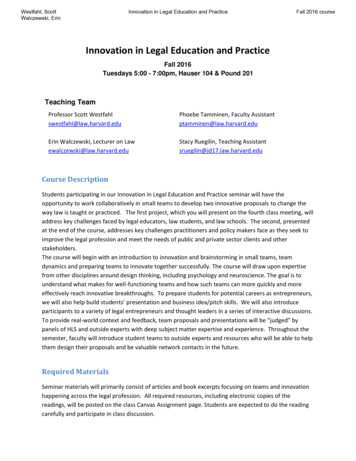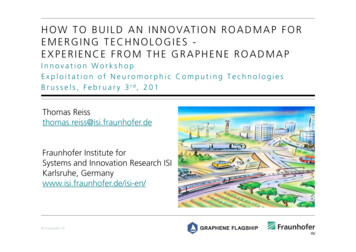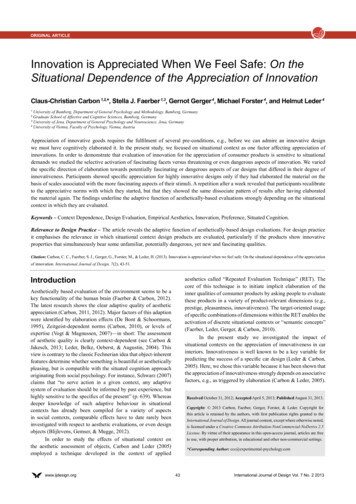
Transcription
ORIGINAL ARTICLEInnovation is Appreciated When We Feel Safe: On theSituational Dependence of the Appreciation of InnovationClaus-Christian Carbon 1,2,*, Stella J. Faerber 1,3, Gernot Gerger 4, Michael Forster 4, and Helmut Leder 4University of Bamberg, Department of General Psychology and Methodology, Bamberg, GermanyGraduate School of Affective and Cognitive Sciences, Bamberg, GermanyUniversity of Jena, Department of General Psychology and Neuroscience, Jena, Germany4University of Vienna, Faculty of Psychology, Vienna, Austria123Appreciation of innovative goods requires the fulfilment of several pre-conditions, e.g., before we can admire an innovative designwe must have cognitively elaborated it. In the present study, we focused on situational context as one factor affecting appreciation ofinnovations. In order to demonstrate that evaluation of innovation for the appreciation of consumer products is sensitive to situationaldemands we studied the selective activation of fascinating facets versus threatening or even dangerous aspects of innovation. We variedthe specific direction of elaboration towards potentially fascinating or dangerous aspects of car designs that differed in their degree ofinnovativeness. Participants showed specific appreciation for highly innovative designs only if they had elaborated the material on thebasis of scales associated with the more fascinating aspects of their stimuli. A repetition after a week revealed that participants recalibrateto the appreciative norms with which they started, but that they showed the same dissociate pattern of results after having elaboratedthe material again. The findings underline the adaptive function of aesthetically-based evaluations strongly depending on the situationalcontext in which they are evaluated.Keywords – Context Dependence, Design Evaluation, Empirical Aesthetics, Innovation, Preference, Situated Cognition.Relevance to Design Practice – The article reveals the adaptive function of aesthetically-based design evaluations. For design practiceit emphasises the relevance in which situational context design products are evaluated, particularly if the products show innovativeproperties that simultaneously bear some unfamiliar, potentially dangerous, yet new and fascinating qualities.Citation: Carbon, C. C., Faerber, S. J., Gerger, G., Forster, M., & Leder, H. (2013). Innovation is appreciated when we feel safe: On the situational dependence of the appreciationof innovation. International Journal of Design, 7(2), 43-51.Introductionaesthetics called “Repeated Evaluation Technique” (RET). Thecore of this technique is to initiate implicit elaboration of theinner qualities of consumer products by asking people to evaluatethese products in a variety of product-relevant dimensions (e.g.,prestige, pleasantness, innovativeness). The target-oriented usageof specific combinations of dimensions within the RET enables theactivation of discrete situational contexts or “semantic concepts”(Faerber, Leder, Gerger, & Carbon, 2010).In the present study we investigated the impact ofsituational contexts on the appreciation of innovativeness in carinteriors. Innovativeness is well known to be a key variable forpredicting the success of a specific car design (Leder & Carbon,2005). Here, we chose this variable because it has been shown thatthe appreciation of innovativeness strongly depends on associativefactors, e.g., as triggered by elaboration (Carbon & Leder, 2005).Aesthetically based evaluation of the environment seems to be akey functionality of the human brain (Faerber & Carbon, 2012).The latest research shows the clear adaptive quality of aestheticappreciation (Carbon, 2011, 2012). Major factors of this adaptionwere identified by elaboration effects (De Bont & Schoormans,1995), Zeitgeist-dependent norms (Carbon, 2010), or levels ofexpertise (Vogt & Magnussen, 2007)—in short: The assessmentof aesthetic quality is clearly context-dependent (see Carbon &Jakesch, 2013; Leder, Belke, Oeberst, & Augustin, 2004). Thisview is contrary to the classic Fechnerian idea that object-inherentfeatures determine whether something is beautiful or aestheticallypleasing, but is compatible with the situated cognition approachoriginating from social psychology. For instance, Schwarz (2007)claims that “to serve action in a given context, any adaptivesystem of evaluation should be informed by past experience, buthighly sensitive to the specifics of the present” (p. 639). Whereasdeeper knowledge of such adaptive behaviour in situationalcontexts has already been compiled for a variety of aspectsin social contexts, comparable effects have to date rarely beeninvestigated with respect to aesthetic evaluations, or even designobjects (Blijlevens, Gemser, & Mugge, 2012).In order to study the effects of situational context onthe aesthetic assessment of objects, Carbon and Leder (2005)employed a technique developed in the context of appliedwww.ijdesign.orgReceived October 31, 2012; Accepted April 5, 2013; Published August 31, 2013.Copyright: 2013 Carbon, Faerber, Gerger, Forster, & Leder. Copyright forthis article is retained by the authors, with first publication rights granted to theInternational Journal of Design. All journal content, except where otherwise noted,is licensed under a Creative Commons Attribution-NonCommercial-NoDerivs 2.5License. By virtue of their appearance in this open-access journal, articles are freeto use, with proper attribution, in educational and other non-commercial settings.*Corresponding Author: ccc@experimental-psychology.com43International Journal of Design Vol. 7 No. 2 2013
Innovation is Appreciated When We Feel Safe: On the Situational Dependence of the Appreciation of InnovationTo generate specific (associative) contexts for the participantswe confronted them with evaluative dimensions that eitherstressed the potentially positive aspects of innovativeness usingfascinating, novelty-based attributes (condition Fascination) oremphasised potentially negative aspects of innovativeness byemploying threatening properties of innovation, namely unfamiliarobjects (condition Danger). We conducted the experimentalprocedure twice—the second testing after a one-week break.This temporal variation is a new way to show another importantaspect of dynamic changes in appreciation and allows for thetesting of whether (and which) situational context enablessustainable changes in aesthetic appreciation. As dependentmeasures, we not only focused on attractiveness or liking, butfollowed a multidimensional approach of assessing aestheticappreciation (see for a deeper discussion on the multidimensionalmeasurement of aesthetic appreciation in Faerber et al., 2010). Forassessing aesthetic appreciation we used the following variables:1) attractiveness, 2) innovativeness, 3) interestingness, 4) owninginterest unlimited, and 5) owning interest limited (see methodsection for details).ExperimentExperiment DesignParticipantsFifty-one undergraduate students of the University of Viennaparticipated for course credit. Twenty-four people (17 women and7 men; mean age 21.6 years) were assigned the Fascinationcondition and 27 (19 women and 8 men; mean age 22.0years) the Danger condition. All participants had normal orcorrected-to-normal visual acuity and normal colour vision,as was assured by a standard Snellen Eye chart test and a shortversion of the Ishihara colour test. None of the participants hadany specific expertise concerning the car industry or car (interior)design, as was assured by participants’ self-reports.Claus-Christian Carbon studied Psychology (Dipl.-Psych.), followed byPhilosophy (M.A.), both at University of Trier, Germany. After receiving hisPhD from the Freie Universität Berlin and his “Habilitation” at the Universityof Vienna, Austria, he worked at the University of Technology Delft,Netherlands and the University of Bamberg, Germany, where he currentlyholds a full professorship leading the Department of General Psychology andMethodology and the “Forschungsgruppe EPÆG”—a research group devotedto enhancing the knowledge, methodology and enthusiasm in the fields ofcognitive ergonomics, psychological aesthetics and design evaluation. Seewww.experimental-psychology.com and www.epaeg.de for more details. Heis an editor of the scientific journals Perception and i-Perception, an ActionEditor of Art & Perception and a member of the Editorial Board of Advancesin Cognitive Psychology. In 2013 he founded the Graduate School of Affectiveand Cognitive Sciences in Bamberg, Germany.Apparatus and stimuliThe stimulus set comprised 18 images of artificial car-interiorshaving a size of 800 513 pixels (see Figure 1 for the stimulus set),and were presented on a 17-inch Apple eMac CRT monitor witha resolution of 1024 768 pixels. The stimuli had been generatedusing Adobe Photoshop 7.0. In order to create a stimulus setmarked by sufficient heterogeneity of innovativeness, we arrangedfor a systematic variation of the images so that the focus variableInnovativeness (9 low, 9 high) was fully crossed with regard toComplexity (6 low, 6 medium, 6 high) and Curvature (6 low, 6medium, 6 high), two dimensions highly important in designand preference (see Bar & Neta, 2006; Imamoglu, 2000; Leder& Carbon, 2005).The validity of the resulting crossing-levelswas tested by several pre-studies (see Gerger, Leder, Faerber,& Carbon, 2011). Importantly, in contrast to the line-drawingversions used in Leder and Carbon (2005), the stimuli used in thepresent study consisted of grayscale, photo-realistic versions ofcar interiors (see Figure 1).Stella J. Faerber received her degree in Psychology (Mag.) from the Universityof Vienna, Austria, where she was supervised by Herbert Bauer at the BrainResearch Lab. After working with Helmut Leder and Claus-Christian Carbon ina project on the dynamics of aesthetic appreciation she received her PhD (Dr.)from the University of Bamberg, Germany under supervision of Claus-ChristianCarbon. She visited the Perception Lab at the University of St. Andrews,United Kingdom, to do research with David I. Perrett on the attractiveness offaces. Right now she is working with Stefan R. Schweinberger and the PersonPerception research group at the University of Jena. Stella J. Faerber is partof the research group “EPÆG” (www.epaeg.de) and interested in aesthetics,adaptation, learning and perception.Gernot Gerger studied Psychology (Mag.), followed by a PhD (Dr.) at theFaculty of Psychology, University of Vienna, Austria. He currently holds apost-Doc position at the Department of Basic Psychological Research andResearch Methods, Faculty of Psychology, University of Vienna which has aresearch focus on empirical aesthetics. He is mainly interested in studying theinterplay of emotional and cognitive processes in aesthetic evaluations. Studyingthis interplay can contribute to a deeper understanding of how cognitive andemotional processes form human attitudes and experiences. In order to betterunderstand different aspects of this interplay in dependence of different objectclasses (design, art, faces) and contextual variables he combines a diverse setof methods by employing psychophysiological measurements (facial EMG) incombination with explicit measures.ProcedureThe experiment consisted of two sessions that were separated bya week-long break. Each session consisted of three parts: first atest phase (T1 or T3 for session 1 or 2, respectively), a contextactivation phase realised via RET and a re-test phase mirroringthe first test phase (T2 or T4 for session 1 or 2, respectively).Thus, the whole experiment followed the following procedureof phases: session 1: T1 RET T2 break (one week) session 2: T3 RET T4. In each of the four test phases (T1-T4),participants rated the complete stimulus set block-wise accordingto the following pre-defined order of variables: 1) attractiveness,2) perceived innovativeness, 3) interestingness, 4) owning interestunlimited, and 5) owning interest limited. Attractiveness andMichael Forster is a PhD candidate and researcher at the Department of BasicPsychological Research and Research Methods, Faculty of Psychology, Universityof Vienna, Austria. He received his master’s degree (Mag.) in psychology fromthe University of Vienna, Austria. Currently, he is part of the research focus onpsychological aesthetics. His research interests cover the interplay of cognitionand emotion at early levels of visual perception. Furthermore, he is interested inresearch on facial attractiveness and art appreciation.Helmut Leder is Professor of Psychology at the University of Vienna, Austria.He studied Psychology in Düsseldorf, Bonn and Aachen, and received a PhDfrom University of Fribourg (CH) and a “Habilitation” from Freie UnversitätBerlin (D) in 2001. Since 2004 in Vienna, he is Head of the Department of BasicPsychological Research and Research Methods, speaker of a research focus onPsychological Aesthetic, and since 2011 co-founder of a Cognitive SciencesResearch platform. His research focus is on empirical aesthetics and psychologyof the arts.www.ijdesign.org44International Journal of Design Vol. 7 No. 2 2013
C.-C. Carbon, S. J. Faerber, G. Gerger, M. Forster, and H. LederCurvaturehighlow innovativehigh innovativelow innovativehigh innovativelow innovativemediumhigh ssmedium complexhigh complexComplexitylow complexlowFigure 1. Stimuli used in the experiment.The stimuli varied in curvature (columns), complexity (major rows), and innovativeness (minor rows).www.ijdesign.org45International Journal of Design Vol. 7 No. 2 2013
Innovation is Appreciated When We Feel Safe: On the Situational Dependence of the Appreciation of Innovationperceived innovativeness were asked for in the first two blocksof each test phase as they were our focal dependent variables.In order to include alternative measures of positive attitudetowards the stimulus, we also measured
www.experimental-psychology.com and www.epaeg.de for more details. He is an editor of the scientific journals Perception and i-Perception, an Action Editor of Art & Perception and a member of the Editorial Board of Advances in Cognitive Psychology. In 2013 he founded the Graduate School of Affective and Cognitive Sciences in Bamberg, Germany. Stella J. Faerber received her degree in Psychology .
